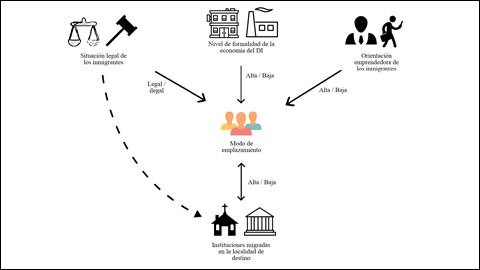"I am Romanian, but Castelló is my home"

23/05/2018
Researchers at the Universitat Autònoma de Barcelona (UAB) and Universitat Jaume I de Castelló (UJI) have analyzed the influence of industrial districts in the mode of settlement of immigrant population, based on the study of the population from Romanian origin in Castelló de la Plana, where this nationality came to represent 14% of the total population in 2012.
Industrial districts are areas specialized in the manufacture and commercialization of the same end product, as in the case of tiles in Castelló de la Plana. The research has allowed to identify what traits favor that migrants end up integrating themselves in the economic and social fabric without special difficulties. Also, this work poses a general model of interaction between the different intervening factors.
Thus, the characteristics of employment formality or informality of the industrial district itself, together with the legal situation and the entrepreneurial orientation of migrants, interact with the own institutions created by migrants at the local level, to define in what way these people will emplace themselves in the economy and everyday life of the destination place. Specifically in the case of Castelló, the high level of formal employment of the tile sector, distributed in different places of La Plana, provided stability and continuity to migrants of Romanian origin (and from other origins as well), who made the decision to stay in a city that they ended up seeing as their "home", despite their self-identification as Romanian citizens.
This positive influence of the industrial sector was enhanced with the web of civic and religious Romanian institutions, supported by the Consulate of Romania in Castelló, with the collaboration of the local administrations. This situation allowed to increase the absorption capacity of citizens of this nationality, which, comparatively, found more favorable conditions than other collectives.
"So far the role of industrial districts has been ignored in the study migrant enclaves. The case we have studied is a remarkable example of success in a context in which other migrant enclaves have experienced conflicting situations in other industrial districts”, explains José Luis Molina, researcher at the UAB and one of the authors of the study.
"Our research also shows how the economic crisis strengthened the desire to consider Castelló as the new base from which to seek temporary or temporary employment in other provinces, or countries, to end up returning home once the conditions were better, how, in fact, it's happening right now. " says Luis Martínez Cháfer, researcher at the UJI and co-author of work.
The interaction model proposed by the researchers has been developed based on an ethnographic study of the Romanian population in Castelló, personalized interviews and statistical sources, and can be developed and tested with other industrial districts associated to migrant enclaves in Europe.
The research was carried out by José Luis Molina and Miranda Lubbers, researchers from the Research Group on Fundamental and Oriented Anthropology (GRAFO) of the UAB, and Luis Martínez-Cháfer and Francesc Xavier Molina-Morales, researchers from the Strategic Alliances Group Networks and Territory (AERT) of the UJI, within the framework of the projects financed by MINECO (CSO2015-68687-P and ECO2015-67122-R).
Reference: Molina, J. L., Martínez-Cháfer, L., Molina-Morales, F. X., & Lubbers, M. J. Industrial districts and migrant enclaves: a model of interaction. European Planning Studies, (2018) 1-21. https://doi.org/10.1080/09654313.2018.1455808
To enlarge the image of this information, click this link